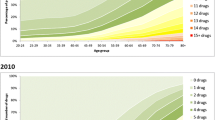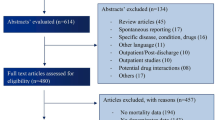Abstract
Purpose
In modelling studies using pharmacists’ opinions, drug-related morbidity (DRM) and preventable DRM have been more common than in observational studies, and the resulting costs are extensive. Modelling studies’ estimates may vary depending on informants’ profession. The purpose of this modelling study was to estimate the proportion of patients with DRM and preventable DRM and the cost of illness (COI) of DRM in Sweden based on physicians’ expert opinions.
Method
A conceptual model of DRM was modified from previous studies. Using a modified Delphi technique, a panel of physicians (n = 19) estimated the probabilities of DRM, preventable DRM, and clinical outcomes of DRM separately for outpatients and inpatients. DRM included new medical problems (adverse drug reactions, drug dependence, and intoxications by overdose) and therapeutic failure (insufficient effects of medicines, and morbidity due to untreated indication). A COI analysis included the direct costs of DRM.
Results
Physicians estimated that 51 ± 22% [mean ± standard deviation (SD)] of outpatients experience DRM and 12 ± 8% preventable DRM. Of inpatients, 54 ± 17% was estimated to experience DRM and 16 ± 7% preventable DRM. Of outpatients with DRM, 24 ± 11% was estimated to experience preventable DRM, whereas this proportion for inpatients was 31 ± 15%. The estimated COI was 376 euros per outpatient and 838 euros per inpatient.
Conclusions
Swedish physicians estimated that every other outpatient and inpatient experiences DRM, which is often preventable and costly. As physicians’ estimates on the proportion of patients with DRM were higher than in observational studies in restricted subpopulations, DRM may be more common in the general population than observational studies suggest.



Similar content being viewed by others
References
Leendertse AJ, Visser D, Egberts AC, van den Bemt PM (2010) The relationship between study characteristics and the prevalence of medication-related hospitalizations: a literature review and novel analysis. Drug Saf 33(3):233–244
Krähenbühl-Melcher A, Schlienger R, Lampert M, Haschke M, Drewe J, Krähenbühl S (2007) Drug-related problems in hospitals: a review of the recent literature. Drug Saf 30(5):379–407
Johnson JA, Bootman JL (1995) Drug-related morbidity and mortality. A cost-of-illness model. Arch Intern Med 155(18):1949–1956
Gyllensten H, Hakkarainen KM, Jönsson AK, Andersson Sundell K, Hägg S, Rehnberg C et al (2012) Modelling drug-related morbidity in Sweden using an expert panel of pharmacists. Submitted
Bootman JL, Harrison DL, Cox E (1997) The health care cost of drug-related morbidity and mortality in nursing facilities. Arch Intern Med 157(18):2089–2096
Ernst FR, Grizzle AJ (2001) Drug-related morbidity and mortality: updating the cost-of-illness model. J Am Pharm Assoc 41(2):192–199
Rodríguez-Monguió R, Otero MJ, Rovira J (2003) Assessing the economic impact of adverse drug effects. Pharmacoeconomics 21(9):623–650
Goettler M, Schneeweiss S, Hasford J (1997) Adverse drug reaction monitoring--cost and benefit considerations. Part II: cost and preventability of adverse drug reactions leading to hospital admission. Pharmacoepidemiol Drug Saf 3(6 Suppl):S79–S90
Beijer HJ, de Blaey CJ (2002) Hospitalisations caused by adverse drug reactions (ADR): a meta-analysis of observational studies. Pharm World Sci 24(2):46–54
Winterstein AG, Sauer BC, Hepler CD, Poole C (2002) Preventable drug-related hospital admissions. Ann Pharmacother 36(7–8):1238–1248
Kanjanarat P, Winterstein AG, Johns TE, Hatton RC, Gonzalez-Rothi R, Segal R (2003) Nature of preventable adverse drug events in hospitals: a literature review. Am J Health Syst Pharm 60(17):1750–1759
Thomsen LA, Winterstein AG, Sondergaard B, Haugbolle LS, Melander A (2007) Systematic review of the incidence and characteristics of preventable adverse drug events in ambulatory care. Ann Pharmacother 41(9):1411–1426
Hakkarainen KM, Hedna K, Petzold M, Hägg S (2012) Percentage of patients with preventable adverse drug reactions and the preventability of adverse drug reactions - A meta-analysis. doi:10.1371/journal.pone.0033236
Brown BB (1968) Delphi process: A methodology used for the elicitation of opinions of experts. RAND Corporation. http://www.rand.org/pubs/papers/P3925.html. Accessed 21 Oct 2011
Hallas J, Harvald B, Gram LF, Grodum E, Brosen K, Haghfelt T et al (1990) Drug related hospital admissions: the role of definitions and intensity of data collection, and the possibility of prevention. J Intern Med 228(2):83–90
Nysam (2010) Key figures 2009 in healthcare - Report on consumption of healthcare [In Swedish]. http://mk.quicknet.se/220986/upload/bilder/0/v_rdkonsumtion_09_rapport.pdf. Accessed 28 Sep 2011
Statistics Sweden (2011) Population in Sweden according to gender and age on 31st December 2010 [in Swedish]. http://www.scb.se/Pages/TableAndChart____262459.aspx. Accessed 5 Nov 2011
Bates DW, Spell N, Cullen DJ, Burdick E, Laird N, Petersen LA et al (1997) The costs of adverse drug events in hospitalized patients. Adverse drug events prevention study group. JAMA 277(4):307–311
Evans RS, Classen DC, Stevens LE, Pestotnik SL, Gardner RM, Lloyd JF et al (1993) Using a hospital information system to assess the effects of adverse drug events. Proc Annu Symp Comput Appl Med Care:161–165
Moore N, Lecointre D, Noblet C, Mabille M (1998) Frequency and cost of serious adverse drug reactions in a department of general medicine. Br J Clin Pharmacol 45(3):301–308
Vargas E, Terleira A, Hernando F, Perez E, Cordon C, Moreno A et al (2003) Effect of adverse drug reactions on length of stay in surgical intensive care units. Crit Care Med 31(3):694–698
Swedish Association of Local Authorities and Regions (2010) Comparison of costs and performance in hospital clinics in 2009 [In Swedish]. http://www.skl.se/vi_arbetar_med/statistik/publikationer_-statistik/tkb_2009. Accessed 20 Oct 2011
Swedish Association of Local Authorities and Regions (2011) Statistics on healthcare and regional development 2010 - Activities and economy in local authorities and regions [in Swedish]. http://brs.skl.se/brsbibl/kata_documents/doc40006_1.pdf. Accessed 28 Sep 2011
Swedish Association of Local Authorities and Regions (2011) Wage and price change in the county and consumer price index [In Swedish]. http://www.skl.se/vi_arbetar_med/ekonomi/budget_och_planering/prisindex/landstingsprisindex. Accessed 20 Oct 2011
Sveriges Riksbank (2012) Annual average exchange rates (aggregate) 2010. http://www.riksbank.se/en/Interest-and-exchange-rates/Annual-aggregate-Exchange-rates. Accessed 23 Feb 2012
Morimoto T, Gandhi TK, Seger AC, Hsieh TC, Bates DW (2004) Adverse drug events and medication errors: detection and classification methods. Qual Saf Health Care 13(4):306–314
Stark RG, John J, Leidl R (2011) Health care use and costs of adverse drug events emerging from outpatient treatment in Germany: a modelling approach. BMC Health Serv Res 11:9
Johnson JA, Bootman JL (1997) Drug-related morbidity and mortality and the economic impact of pharmaceutical care. Am J Health Syst Pharm 54(5):554–558
Ferner RE, Aronson JK (2010) Preventability of drug-related harms - part I: a systematic review. Drug Saf 33(11):985–994
Hakkarainen KM, Andersson Sundell K, Petzold M, Hägg S (2012) Methods for assessing the preventability of adverse drug events - a systematic review. Drug Saf 35(2):105–126
Petrou S, Gray A (2011) Economic evaluation using decision analytical modelling: design, conduct, analysis, and reporting. BMJ (Clin Research ed ) 342:d1766
Simoens S (2006) Using the Delphi technique in economic evaluation: time to revisit the oracle? J Clin Pharm Ther 31(6):519–522
Aronson JK, Ferner RE (2005) Clarification of terminology in drug safety. Drug Saf 28(10):851–870
Aronson JK, Ferner RE (2010) Preventability of drug-related harms - part II: proposed criteria, based on frameworks that classify adverse drug reactions. Drug Saf 33(11):995–1002
Acknowledgements
We acknowledge Professor Lyle Bootman and colleagues in the College of Pharmacy, University of Arizona, for access to material on their conceptual model. We also thank the physician panelists and the participants in the pilot. The study was conducted as part of the project Drug-Related Morbidity in Sweden (DRUMS). The authors thank Karolina Andersson Sundell, Anna K Jönsson, and Clas Rehnberg in the DRUMS research group for their contribution to study design. The study was funded by an unrestricted grant from The National Corporation of Swedish Pharmacies (Apoteket AB).
Conflicts of interest
The authors’ work was independent of the sponsor, The National Corporation of Swedish Pharmacies (Apoteket AB), who had no role in study design; data collection, analysis, and interpretation; writing the manuscript, or the decision to submit the manuscript for publication. The authors declare that they have no conflicts of interest.
Disclaimer
The opinions or assertions contained herein are the private views of the authors and are not to be construed as official or as reflecting the views of the Medical Products Agency.
Author information
Authors and Affiliations
Corresponding author
Rights and permissions
About this article
Cite this article
Hakkarainen, K.M., Alström, D., Hägg, S. et al. Modelling drug-related morbidity in Sweden using an expert panel of physicians. Eur J Clin Pharmacol 68, 1309–1319 (2012). https://doi.org/10.1007/s00228-012-1244-3
Received:
Accepted:
Published:
Issue Date:
DOI: https://doi.org/10.1007/s00228-012-1244-3




